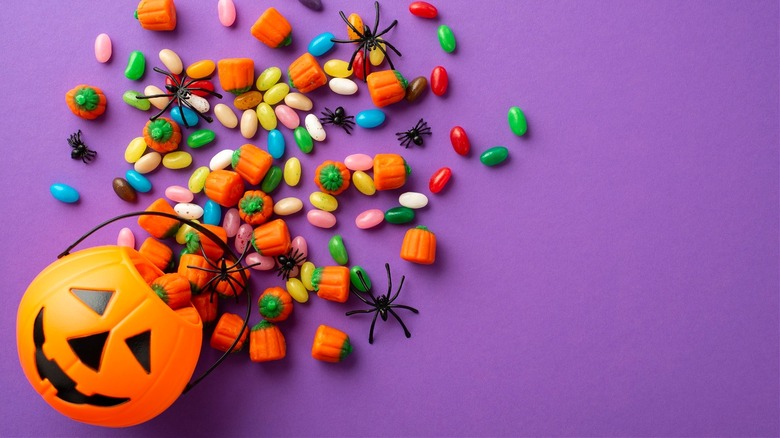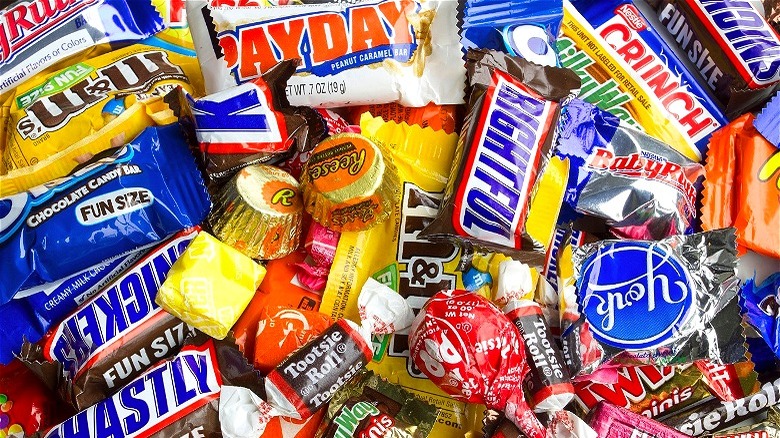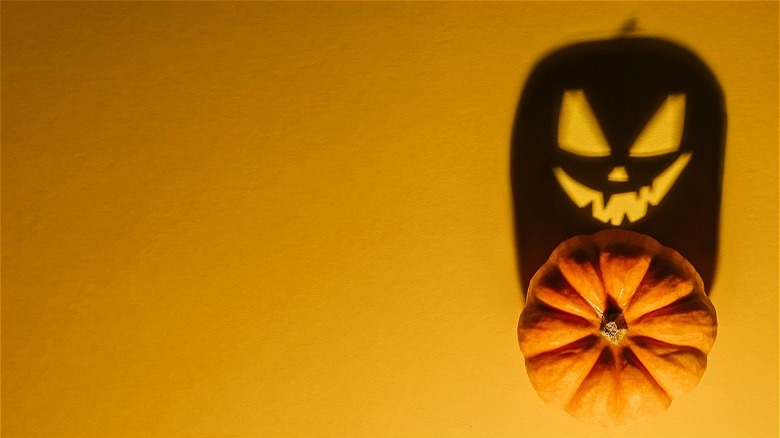How Candy Companies Kickstarted Trick-Or-Treating On Halloween
Trick-or-treating is a long-celebrated pastime enjoyed by many Americans young and old, but candy wasn't always the gift of choice for those trekking door-to-door on October 31st. Halloween dates back to the ancient Celtic celebration Samhain, where the act of "mumming," or performing skits and singing door to door, often resulted in awarded refreshments, per CNN. Later on, when Samhain converged with the Christian celebration of All Saints' Day, "soul cakes" were baked and handed out to children who traveled across towns expressing their condolences for spirits passed.
However, there are stark differences between the history of sweets on the haunted holiday and present-day trick-or-treating in America. Candy has obviously become synonymous with Halloween, but how did that happen? Times Record News expects Americans to shed $3.1 billion on commercial Halloween candy in 2022, but when we glance back in time, Halloween treats used to be solely homemade.
History claims economic hardships in America led to sugar rationing during World War II in the early 1940s, which added constraints to the traditional ways people chose to enjoy the spooky celebration. How did candy parlay into this equation, and more importantly, when did major candy companies become Americans' go-to source for October 31st provisions?
Candy manufacturers take over Halloween
After the economic hardships of the 1930s and '40s, Americans may have been warier of spending all their money on expensive ingredients to make fudge or popcorn balls, but luckily, candy was always marketed as affordable. Author of "Candyfreak" Steve Almond told History that candy bars were even advertised as inexpensive meal replacements during the Great Depression; chocolate bars had been used as rations for soldiers during World War I and as a mood-lifting alternative to alcohol during Prohibition, which spurred the development of over 40,000 distinct candy bars in the U.S.
When it comes to candy becoming popular on Halloween, history points to the advancing development of packaging as fuel for the confection's continued success. While the author of "Sweet as Sin" Susan Benjamin told Time fun size or "junior" candy bars were created to make candy appear smaller and cheaper during the Great Depression, major candy corporations later jumped on the proverbial bandwagon and began marketing these packaged treats to homemakers eager to spread Halloween cheer.
Commercially manufactured candy didn't become the number one choice for trick-or-treaters until the 1970s, however, after a few malicious Americans tampered with loose candies before giving out the poisoned goods to trick-or-treaters. According to Fast Company, these incidents only spurred additional candy business since more parents began to urge kids to only take candy that was commercially packaged. Apart from the advancements in packaging, it seems candy companies were also not afraid to scare consumers into buying their confections.
The hidden threats in Halloween candy advertisements
While the symbolism of October 31st has taken many forms throughout the years by way of elaborate decor and spooky Halloween dishes, the "tricks" behind trick-or-treating were once used as a bargaining tool for many candy companies hoping to attract additional customers.
History describes Halloween in the early 20th century as a day of pranks, and with the onset of the Great Depression, these once-harmless tricks led to serious destruction that eventually poured into cities and resulted in vandalism, fires, and theft. Halloween historian Lisa Morton told Martha Stewart that in the late 1930s, civic organizations developed a plan to wrangle the young by hosting community parties to distract them from potential pranks. After 1936, when trick-or-treating was first mentioned in a national magazine, candy companies began to see the potential of marketing their products to families (especially those with unruly teenagers and youngsters) celebrating the haunted holiday.
According to candy expert and historian Beth Kimmerle in Fast Company, in the 1950s, the growing message from candy companies was, "If you buy the right candy, you won't get tricked." MeTV showcases many Halloween candy ads from the '50s and '60s, and some of the messages indirectly guarantee safety from pranks. A 1960s Milky Way ad purports to "keep 'em on good spookin' terms" rather than loitering on the lawn, and a Curtiss candy company ad insists, "No tricks with Curtiss." While trick-or-treating and candy have been a duo for decades, candy was once used as a tool to denounce juvenile artifice and promote innocent communion (and of course, consumerism).


